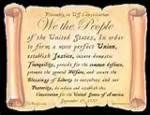“To provide for organizing, arming, and disciplining, the Militia, and for governing such part of them as may be employed in the service of the United States, reserving to the States respectively, the appointment of the officers, and the authority of training the Militia according to the discipline prescribed by Congress.” Article 1, Section 8, Clause 16, US Constitution
This clause is known as “organizing the militia”. The original purpose of the militia was to protect the people of the state from the federal government. The Anti-Federalists thought that the Congress would gradually let the funds for the Militia disappear. The Anti-Federalists advocated the Second Amendment to protect the citizens’ right to bear arms.
Second Amendment: “A well regulated Militia, being necessary to the security of a free State, the right of the people to keep and bear arms, shall not be infringed.”
The Second Amendment did protect the right to bear arms, but the Congress still controlled the Militia. The Militias could still function as originally intended within the State, but Congress has the power to organize, discipline, and arm the Militia for federal purposes.
With the Organizing the Militia clause, the Federalists tried to make the Militia into a national reserve of uniform, interchangeable units.
In 1792, Congress passed the Uniform Militia Act. This established an “obligated” militia. This means that all able-bodied white men between the ages of 18 and 45 had to enroll. This Militia had a very poor performance during the War of 1812. The obligated militia was disbanded. After that, the “uniformed” militia replaced it. Uniformed militia means that it was made up of people who chose to serve. The National Guard replaced the uniformed militia. The National Guardsmen remain volunteers, a Citizen-Soldier.
The National Security Act of 1916 made state militias available for overseas duty as well as being used for domestic disturbances. This functionally stripped the states of militia powers. States may call up the National Guard, but federal government needs take precedence.
“We the people” originally gave Congress the power to organize, arm, and discipline the Militia. Today, that power still rests with Congress, but the intent of having the Militia protect the people of the states from the federal government no longer exists.
The “organizing the militia” clause was originally intended to allow a means for the people of a state to protect themselves from the federal government. Today, this clause allows for “we the people” to have the National Guard for protection during domestic disturbances as well as protection here or abroad as the federal government sees fit.
References:
http://www.heritage.org/constitution/#!/articles/1/essays/56/organizing-the-militia
US Constitution



















